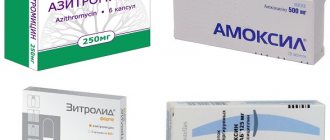The kidneys perform a lot of functions in the human body, which increases the chances of various ailments. The most common pathology is kidney inflammation (nephritis). The disease is divided into several types and requires immediate treatment. Lack of specialist help leads to a gradual loss of organ performance, kidney failure, and the further need for a transplant.
How to suspect the course of the disease in men, what to do if kidney inflammation is detected? First of all, study the symptoms, the causes of the pathology, contact a qualified specialist. Self-treatment of the disease leads to complications and unfavorable outcomes.
Probable causes
Nephritis in men is formed against the background of various unfavorable factors. The pathology can be primary (appears as a result of kidney disease, for example, with urolithiasis) and secondary.
Nephritis actively progresses as a result of exposure to certain circumstances on the patient:
- weakened immunity. Doctors note an outbreak of kidney inflammation in the autumn-spring period, when the body is most vulnerable;
- excessive physical activity or its complete absence;
- constant suppression of the urge to empty the bladder (observed in men who have sedentary work);
- the course of chronic inflammatory processes in the body;
- unbalanced diet, drinking insufficient amounts of fluid (constant dehydration);
- the presence of inflammatory processes in the male reproductive system;
- hypothermia;
- poisoning by various poisons (heavy metals, chemicals);
- the presence of cancer, chronic alcoholism.
Acute nephritis is formed against the background of damage to the kidney tissue by various pathogenic microorganisms (streptococci, Escherichia coli, Proteus, coccal infection). The chronic form of the disease is often a consequence of acute kidney inflammation, lack of or improper treatment.
Less commonly, the pathology develops independently, for example, against the background of long-term use of potent medications (non-steroidal anti-inflammatory drugs, analgesics). Very often, chronic nephritis is diagnosed against the background of cancer.
Find out the instructions for using the drug Uronefron for urological problems.
For a review and characteristics of tablets for urinary incontinence in women, see this address.
Classification and symptoms of pathology
Depending on the type of kidney inflammation in men, the clinical picture varies and the treatment also differs. Only an experienced doctor can identify a specific form of nephritis in men, after carrying out a series of diagnostic procedures.
Glomerulonephritis
With this disease, the kidney glomeruli are affected; the disease is of an immunoinflammatory nature. The pathology often develops against the background of a purulent sore throat caused by group A streptococcus.
Signs of kidney inflammation:
- blood is released along with urine;
- sometimes at the beginning of the pathology there is a complete absence of urine in the victim;
- swelling occurs on the face, in advanced cases it forms throughout the body;
- a sharp increase in blood pressure leads to frequent headaches and dizziness;
- patients often complain of pain of varying severity in the lumbar region.
Pyelonephritis
The nonspecific form of the disease is characterized by damage to the pelvis and calyx of the kidney. The causative agent of this form of the inflammatory process is opportunistic microflora (staphylococci, Escherichia coli). Pyelonephritis is formed in two ways: ascending (bacteria enter from the underlying parts of the genitourinary system); descending (microorganisms are transported in the blood from existing foci of inflammation in the human body).
The clinical picture of pyelonephritis includes:
- sharp pain in the lumbar region, frequent renal colic;
- frequent, painful urination (especially against the background of cystitis);
- increased body temperature, headaches, intoxication of the body, general weakness, impaired potency.
Radiation nephritis
Progresses under the influence of prolonged exposure to ionizing radiation on the patient’s body. The disease leads to dystrophy of the epithelium of the renal tubules and its further atrophy. The pathology is usually chronic, accompanied by back pain, high blood pressure, and painful urination.
Interstitial
The interstitial tissue of the kidneys and tubules are affected. The disease develops against the background of long-term use of non-steroidal drugs and analgesics sold without a doctor’s prescription. The pathology is often accompanied by various rashes on the body and internal bleeding. Patients complain of fever of unknown etiology and general weakness.
Main symptomatic manifestations of the disease
Typically, the disease develops gradually: the first signs are almost invisible and many patients mistake them for overwork or chronic fatigue. This contributes to late diagnosis and the development of complications. The main symptoms of kidney inflammation include:
- Pain in the lumbar region. It intensifies with physical activity, overeating, and alcohol abuse. The appearance of this sensation is associated with stretching of the outer membrane of the kidney due to its swelling.
- Changes in skin color and bruising. Due to impaired filtration function of the kidneys, the body is exposed to toxic substances. Their decay causes the accumulation of harmful metabolic products in soft tissues.
- Formation of edema on the face and upper half of the body. It often occurs in the morning and goes away during the day. This is directly related to impaired renal excretory function.
- Changes in the physical characteristics of urine. It becomes darker and more cloudy due to the presence of foreign elements. Often, urine leakage is accompanied by pain and pain.
- General intoxication syndrome. It manifests itself in the form of increasing nausea and vomiting, headache and fatigue. In 30% of cases, there is an increase in body temperature to 37–39 degrees.
- Increase in blood pressure. Many patients note that the tonometer, instead of the usual 120/80, produces values of 140/90 mmHg and higher. This phenomenon is also associated with the retention of excess fluid in the body.
Photo gallery: symptoms of kidney inflammation
Pain in the lower back is typical of kidney damage
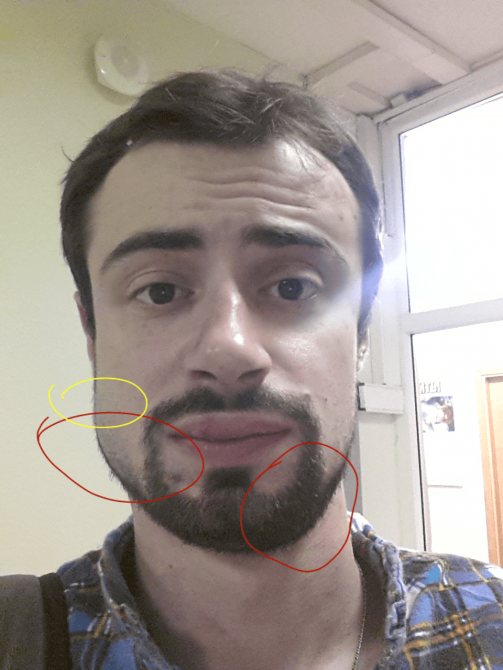
Facial swelling is often observed after prolonged sleep
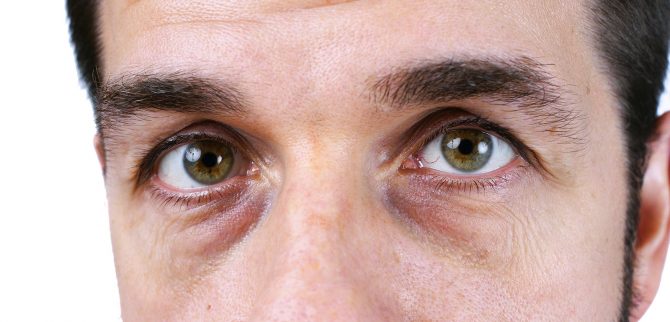
Bruises indicate the presence of excess fluid
Diagnostics
Doctors are able to identify the cause of a patient’s poor health through special diagnostic procedures:
- Laboratory tests are mandatory: biochemical, general blood test of the patient, urine tests, blood test for electrolytes, bacteriological urine culture;
- instrumental studies: ultrasound of internal organs, in particular kidneys, monitoring of the victim’s blood pressure;
- Additional manipulations include: immunological examination, biochemical urine analysis, radioisotope diagnostics of the kidneys.
In severe situations, a kidney biopsy is required. The method allows you to quickly make a diagnosis. During the study, examinations by other specialists may be prescribed to identify chronic foci of inflammatory processes. Also, an immunologist may be involved in the treatment of nephritis in men, since the main mechanism for the formation of pathology is immune.
General rules and methods of treatment
How to treat kidney inflammation? Nephritis in men is a serious problem that requires immediate treatment.
Important! Taking any medication on your own is strictly prohibited. Only a specialist, after carrying out a series of diagnostic measures, will prescribe the necessary course of therapy that is suitable for you.
First aid
In case of acute pain due to kidney inflammation, it is recommended to call an ambulance. While waiting for doctors, it is not recommended to take strong painkillers, which can distort the clinical picture and complicate the diagnosis of pathology. The best option is to take a warm bath; hot water helps relieve pain and eliminate muscle spasms.
Drug therapy
Treatment of kidney inflammation in men involves the use of vitamin-containing preparations (including calcium, thiamine, riboflavin). Therapy at home is prohibited; treatment of nephritis should be carried out under the strict supervision of doctors.
Effective drugs for the treatment of kidney inflammation:
- Cyclophosphomide. Available in tablet form, take on an empty stomach with a small amount of mineral water. It is prohibited to use the medication in the presence of cancer or nephrosis. The drug must be accompanied by a diet and the use of diuretics;
- Ceftriaxone. It is administered intramuscularly or intravenously. The daily intake for an adult should not exceed 4 grams. Prescribe with caution to patients with diabetes.
Additionally, the patient is prescribed:
- anti-inflammatory drugs. Medicines stop the inflammatory process and relieve swelling. Anti-inflammatory drugs are taken in short courses; for nephritis, the following are used: Norfloxacin, Ciprofloxacin, Verapamil;
- antibiotics for kidney inflammation. Aimed at destroying pathogenic microflora that caused the inflammatory process. The specific dosage and duration of therapy are prescribed by the doctor. Amoxicillin, Penicillin, Cephalexin are often used;
- antihistamines help limit the formation of antibodies to kidney tissue (Suprastin, Zyrtec);
- diuretics. Helps remove harmful substances from the body (Diacarb, Furosemide).
Hemodialysis
It is a special procedure by which a special machine purifies the patient’s blood. It is prescribed in serious situations if the kidneys cannot cope with their functions. Hemodialysis cleanses the victim's body of metabolic products and improves the patient's well-being. The measure is temporary; the patient requires a kidney transplant.
Folk remedies and recipes
Treatment of kidney inflammation with folk remedies:
- healing collection. Combine coltsfoot grass, yarrow, St. John's wort, nettle, and centaury in equal proportions. Pour a tablespoon of the resulting mixture with a glass of boiling water, let it brew for one hour. Strain the product, take half a glass twice a day, the course of therapy should last at least 25 days;
- decoction. Grind flax seeds, strawberries, stinging nettle, and birch leaves in equal proportions. Pour a glass of boiling water over a teaspoon of the resulting mixture and simmer for a quarter of an hour. Strain the resulting product, divide into two parts, take in the morning and evening. The duration of treatment depends on the patient’s condition and the severity of unpleasant symptoms;
- parsley. Finely chop two thick parsley roots, add half a liter of water and the same amount of milk. Boil the product a little, judge, strain. Take the decoction 100 ml per day, the course of therapy lasts a month, after 30 days it is repeated.
What are microliths of the left kidney and what are the features of the treatment of formations? We have the answer!
Read about removing kidney stones using diet and special nutrition at this address.
Follow the link https://vseopochkah.com/mochevoj/mocheispuskanie/uretrit-u-zhenshin.html and find out what antibiotics need to be taken for urethritis in women.
Diet and nutrition rules
Recommendations:
- limit salt intake (no more than 1.5 grams per day);
- drink at least 1.5 liters of clean water per day;
- steam, bake, boil all dishes; frying and stewing are prohibited;
- take a decoction of rose hips, you are allowed to drink fruit drinks and natural juices;
- Avoid eating smoked meats, sweets, fried, spicy and salty foods. It is not recommended to eat radishes, seaweed, peas, and legumes;
- Milk with a small amount of soda will help relieve swelling;
- It is allowed to eat lean meats, vegetables, fruits, and all types of greens. Be careful with dairy products and listen to your doctor's recommendations.
The diet is prescribed by the doctor, taking into account the characteristics of the patient. It is not recommended to make such serious decisions on your own.
How do kidneys hurt and what are the symptoms in men?
Many people have experienced and know how kidneys hurt; the symptoms in men are in many ways similar to the female symptoms of the disease. The incidence of the disease in the stronger sex is only 15% of the total.
The remaining 85% occurs in women, who are more susceptible to kidney disease due to their body structure. At first glance, the symptoms of diseases in women and men are the same, but this is not the case.
Symptoms appear specifically in men.
The main difference is the intensity of the pain. It is 2-3 times higher than in women. Therefore, the male part of the population suffers more from kidney dysfunction and requires sick leave in the early stages of the disease. At the same time, kidney failure can be caused or exacerbated by ailments that are unique to men.
What determines the intensity of pain?
The severity of pain in men varies depending on several factors. This:
- specific type of kidney disease in men;
- localization of dysfunction;
- presence of complications;
- the reason for the development of the problem.
What makes the sensations ultimately different? The greater the prevalence of dysfunction, the greater the discomfort, nausea, vomiting and other characteristic signs of kidney disease.
Complications also worsen the overall symptomatic picture.
If the cause of the disease is a separate severe kidney disease, then the patient’s condition quickly deteriorates due to the complex effects of several harmful factors at once.
What diseases cause symptoms?
Painful sensations become especially intense with specific ailments. They can also occur in the case of extensive mechanical damage (frostbite, burn, blow to the kidney area), but the main cause of all pain is one of the following ailments:
- hydronephrosis;
- disease of the ureters and bladder;
- manifestations of renal failure;
- pyelonephritis;
- nephroptosis;
- some other rare diseases.
Kidney pain is acute
The most common manifestation of these ailments is acute pain, the symptoms and treatment of which vary depending on the disease. When kidney function is impaired, the nerve endings of the organ are irritated. They transmit a signal to the brain about danger, thereby causing pain.
Most of the male population, faced with kidney problems, prefers to endure the unpleasant sensation. This is wrong behavior. Acute pain, pain, pulsation, twisting are signs of the transition of ailments to a life-threatening form.
If the patient hesitates and chooses to wait without calling a doctor, the kidneys may be too severely damaged and will no longer be able to regenerate.
The cost of delaying pain is the health of the whole body, the kidneys that will have to be transplanted, and even the life of the patient himself.
Since organ transplantation is a procedure with a high risk to life, and the functioning of the body without kidneys is impossible, death is likely. Only timely consultation with a doctor will help reduce the risk of death and increase the likelihood of a complete cure of the damaged organ and adjacent tissues.
cause of pain
Unpleasant sensations in the kidney area are almost always characterized by lumbar pain. They are called renal colic. Colic occurs as a reaction to most of the problems listed and is a symptom sufficient for hospitalization of the patient. This is also the main reason why kidneys hurt in men.
Colic is based on a mineral stone, a deposit that forms in the kidney as a result of disruption of its function. This formation can be excreted from the organ through the bile ducts, causing acute pain.
Renal colic
The main symptoms of kidney disease in men:
- pain in the lumbar region is pulsating, comes in waves and seems to grip the entire lumbar region;
- in the later stages in men, symptoms are expressed as severe pain in the scrotum and groin area;
- Nausea appears, with strong urges turning into vomiting.
Colic may occur when a small stone passes along the path. If its size does not exceed a few millimeters, there is a chance that it will come out without outside intervention. If the stone is large, then surgery and special medications will be required.
Diagnostics using radiography or tomography, and in rare cases, ultrasound, can determine the size of the deposit. This is a mandatory procedure that is prescribed in all cases of renal colic.
Painful sensations gradually develop. They begin with minor discomfort and end with severe unpleasant sensations that block the ability to live normally:
- The first stage is characterized by mild, throbbing pain. They are similar to manifestations of radiculitis and intensify with movement and bending.
- In the second stage, the sensations become spasmodic. They rise and fall sharply, which is repeated several times over a short period of time.
- Gradually the feeling begins to “decrease”: it moves to the scrotum and groin. The final point of its distribution is the thigh, the last tissue that is adjacent to the ureters and can, when touching a stone, transmit pain signals to the brain.
Increasing pain to the point of immobility
As discomfort increases, the patient becomes immobilized. He cannot move, and when lying down it is difficult for him to find the correct and comfortable position. The spasm does not decrease depending on the position of the body. Due to the particular severity of pain, men may begin to vomit as a side effect of severe malaise.
Specific male diseases that increase pain
There are a number of diseases that, due to the physiology of the body, appear only in the stronger sex. Violations relate to the groin area: prostate, scrotum, genitals.
The main ailments that can affect the condition of the kidneys:
These pathologies make it difficult to urinate. As a result, the ureters become clogged and stones can form in the bladder. Intoxication of the body occurs, and the kidneys may also be affected.
With adenoma and prostatitis, an inflammatory process occurs in the groin area, which can spread to the kidneys. The result of ignoring pain and inflammation in this case will be the development of pyelonephritis.
The kidney tissue dies, and the organ can be completely rejected by the body. This will result in death.
To prevent the death of a patient, if one of the listed disorders is detected, an urgent diagnosis is prescribed, based on the results of which treatment is selected. Due to the presence of sexual diseases that aggravate the situation, the diagnostic and treatment procedure for men is also different.
Diagnosis of kidney dysfunction in men
During diagnosis, you need to be as frank as possible with the diagnostician. You need to contact a therapist or surgeon; if there is a separate diagnostician (rarely found in Russian practice), it is best to contact him.
Diagnosis of the disease
A man must describe the following points:
- symptoms of the disease;
- time of onset of discomfort;
- probable causes of their occurrence (food, frostbite, shock);
- the presence of forcing pathologies (adenoma or prostatitis);
- the rate of increase in unpleasant sensations;
- localization of pain (lower back, groin area, scrotum, ureters, thigh);
- are there differences in the nature of sensations depending on body position;
- nature of pain (spasms, throbbing, gripping, continuous).
The presence of renal failure can be determined by:
- skin color (it becomes yellowish if there is a failure in the kidneys);
- the position of the patient’s body during hospitalization (if the man was found in a crouched state, this indicates the presence of severe pain either in the abdomen, or in the lower back or groin);
- the condition of the mucous membranes (with kidney disease they are paler, the body’s nutrition is noticeably impaired);
- the presence of plaque on the teeth (dark plaque may appear due to intoxication of the body).
After the profile of the disease has been determined, the patient is sent for examination: a tomography, ultrasound or x-ray is done. The entire area of the kidneys and their canals is necessarily visible, starting from the organ and ending with the ureters and bladder. If the patient talks about the pain as colic, then special attention should be paid to the channels.
An additional screening measure is checking for the presence of concomitant diseases. First of all, the likelihood of having a disease that leads to urinary problems is considered:
- adenoma;
- prostate;
- cystitis;
- kidney tuberculosis, etc.
Kidney ultrasound
In no case should you hide the presence of sexual problems, because they can serve as a complication during treatment and prevent therapy from taking place as soon as possible. If a person hides some of his problems, this will result in organ failure and a long wait in line for a transplant.
To detect side infections, a blood test is prescribed, and sometimes a puncture of tissue from an organ is done. A urine test gives a complete picture of the presence of abnormalities. The detection of an increased calcium content, excess red blood cells or purulent discharge in it indicates serious abnormalities in the body.
Treatment of kidney dysfunction in men
Therapy is carried out taking into account all the characteristics of the male body. Particular emphasis is placed on painkillers:
- During inpatient treatment, injections or intravenous drips of sedatives and painkillers are regularly given. Even semi-narcotic drugs are used, but not more than 10 days while the patient is in intensive care. The need to use such potent drugs is caused by the low pain threshold of male patients in relation to the renal area.
- After transfer to the general ward, the patient is transferred to potent analgesics, but without the use of narcotic substances. A characteristic feature of the treatment is that drugs with serious side effects are tried to replace placebo. Every other day, pacifiers are given, because otherwise the kidneys will only “sit down” faster due to the use of a shock portion of active substances. Often patients do not notice changes because they numb the pain psychologically.
- Upon discharge home, a course of prescription pain medications is prescribed. They can be purchased at most chain pharmacies.
After successful completion of therapy, the patient switches to the maximum permitted analgesics such as Aspirin, which are available without a prescription. They may be needed to eliminate side effects: painful urination. By the time of discharge from the hospital, the main colic had already been eliminated.
In addition to painkillers, procedures are prescribed that help cleanse the body. Antibiotics are used to fight infections, and if the body is affected by intoxication and has waste and toxins, antioxidants are used.
The most problematic situation is the inflammatory or necrotic process of the kidneys. The man undergoes surgery under mandatory general anesthesia, during which dead cells are removed. To reduce inflammation, antihistamines are taken orally and injections of various substances are made.
Kidney disease in men can be easily detected in the initial stages. It is important not to delay treatment, otherwise the disease will enter the terminal stage.
Source: https://LibidoGuru.ru/bolezni/kak-bolyat-pochki-i-kakovy-simptomy-u-muzhchin.html
Preventive recommendations
Experts recommend preventing kidney inflammation in men in several ways:
- avoid hypothermia;
- do not wear tight trousers, they hinder movement, lead to compression of the groin area, and the formation of a number of diseases;
- Avoid drinking drinks containing alcohol and avoid stress;
- promptly treats all inflammatory processes in the body;
- reduce the consumption of fried and smoked foods.
Nephritis is common in men. Treat the disease in a timely manner, do not let the disease take its course. Timely therapy is the key to the absence of complications and a favorable prognosis.
The topic of the next video is kidney inflammation, causes and treatment:
Types of kidney diseases in men
Due to the anatomical features of the urinary system, kidney diseases are less common in men than in women. A long and narrow urinary canal prevents infection.
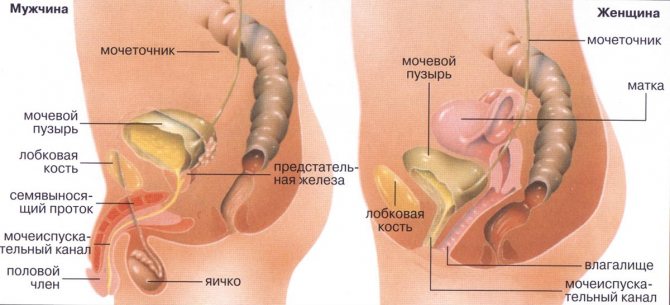
In men, the urethra is narrow and long, which reduces the percentage of diseases caused by bacterial infection
The most common kidney diseases in men are:
- Pyelonephritis is an inflammatory disease of the kidneys, which affects the pelvis, calyces and lining of this organ.
- Glomerulonephritis is an inflammatory process that affects only the glomeruli (glomeruli).
- Nephrolithiasis (urolithiasis) is the deposition of stones in the kidneys. These can be: calcium salts (phosphates, oxalates, carbonates);
- ammonium phosphate magnesium stones;
- urates (uric acid salts);
- cystine and xanthine stones (salts of cysteine and xanthine acids).
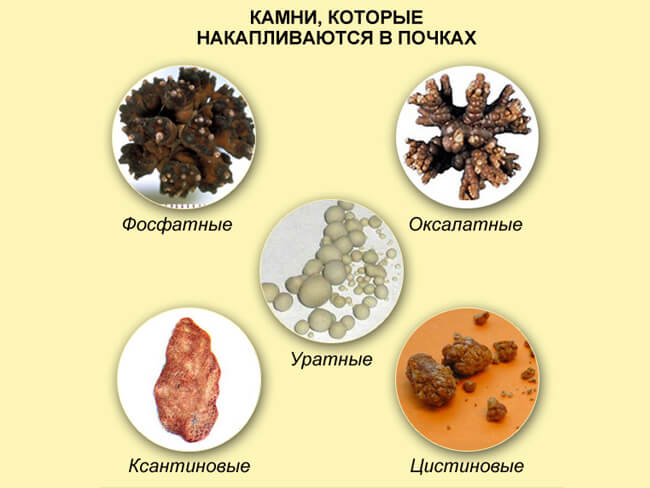
Kidney stones vary in density and chemical composition.
Men listen to their bodies less than women. They do not rush to the doctor as soon as they feel unwell. Therefore, by the first visit to the doctor, the disease often has time to become chronic. This leads to a decrease in the effectiveness of treatment and periodic relapses of the disease.
Photo gallery: what kidneys look like in various diseases
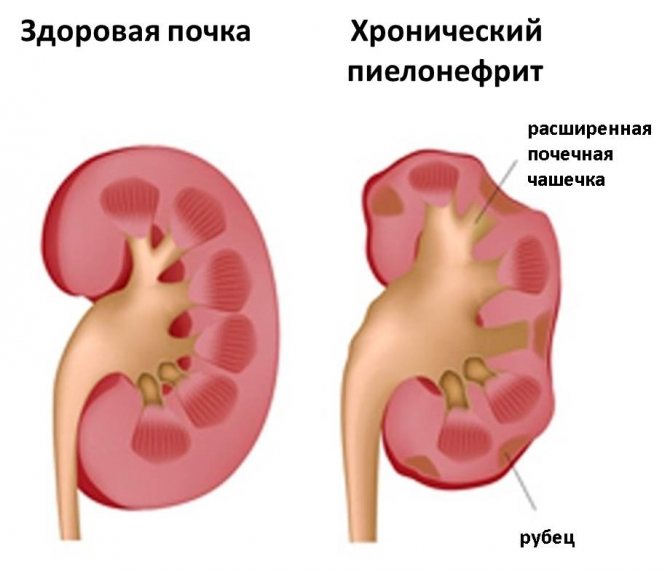
If pyelonephritis becomes chronic, then scars appear in the kidney, it shrinks, and its calyces expand
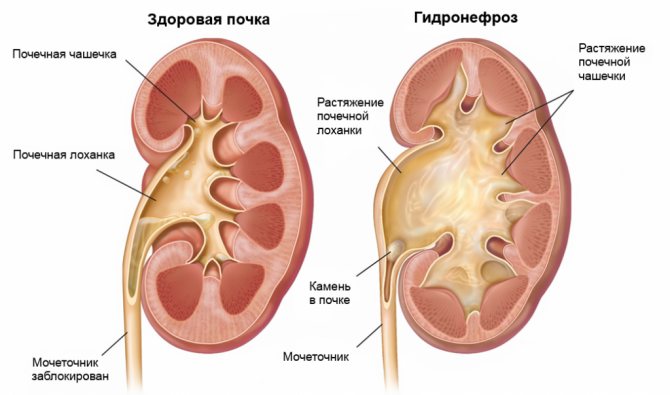
With hydronephrosis, the renal collecting system greatly expands
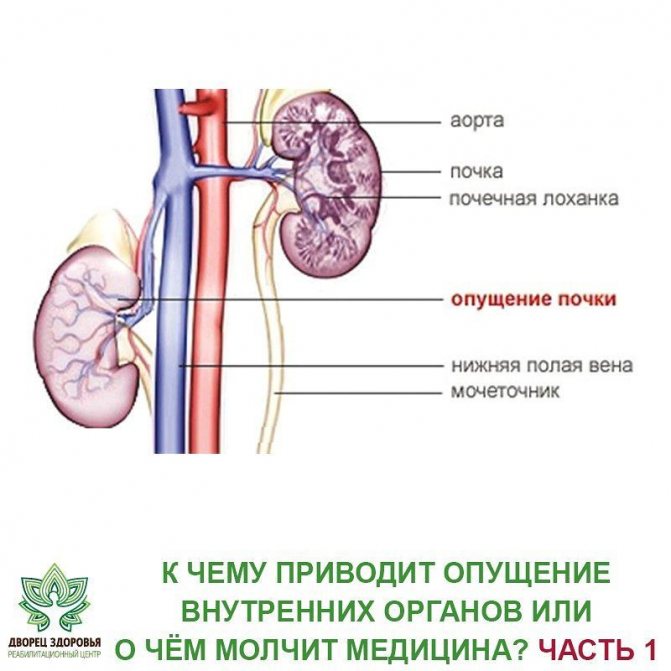
With nephroptosis, the kidney moves downward from its usual location
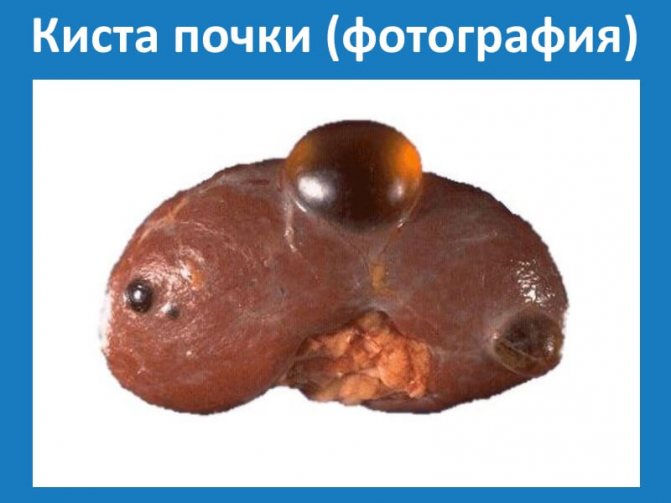
A cyst is clearly visible on the kidney - a benign neoplasm filled with fluid.
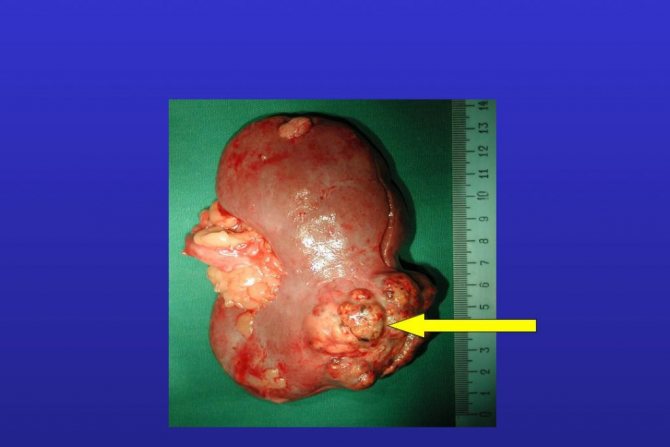
Malignant kidney tumors make it impossible for the organ to perform its inherent functions




